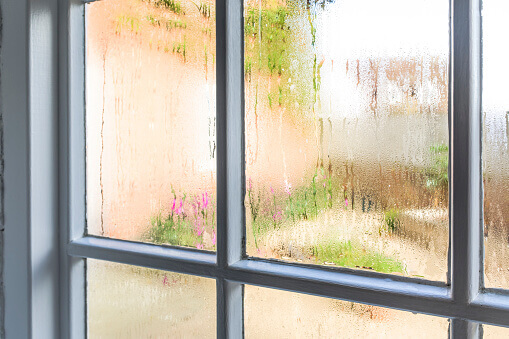Summer Humidity Meets Hardwood Floors – What You Need to Know

One of the many ways you can tell high summer humidity in homes is moisture on your windows. Read on to see how to prevent this.
There is no denying that hardwood floors are a beautiful addition to any home. Not only do they add home value but they can stand the test of time. However, it’s a natural product and with that, it responds to different humidity levels. Elite Hardwood Flooring is located in Maryland, so we know our fair share of humid summers. So, while seasonal movement is normal, here is what you need to know when summer humidity meets hardwood floors.
High Summer Humidity Levels
When you break it down, it makes sense. Humidity is how much moisture is in the air. So when there is high humidity, your hardwood floors absorb some of that moisture. This causes them to expand or swell. A lot of this is typical and very much considered during the installation of your floors. Most households find that between 30 – 50% humidity is ideal. That isn’t just for your comfort either. Wood floors like to stay within those levels, too.
While there is damage that can happen if it goes below 30%, what happens when it goes higher than 50%? Wood floors really don’t like anything over 55% humidity. It is important to note, it does change based on the type of wood floors you have, so please make sure to check with your manufacture recommendations. When humidity gets too high, this can cause the floors to cup or warp. It can also raise the risk of mold growth and insect infestations. All things homeowners want to prevent.
How to Measure & Control Humidity
Now that you know what to avoid, how do you know your humidity levels? First, if you don’t have a hygrometer in your home already, you can purchase one at most drugstores. They are a simple way to test humidity levels from room to room. Second, newer thermostats can also help measure humidity levels. They have a sensor that helps not only ready but help adjust the temperature in your house if it is too high or low. Make sure to check your manual to see the humidification settings.
No matter what you have, if your levels are too high here are some ways to help with high humidity in your home:
- Install a house dehumidifier or have one for larger rooms, like the living room/kitchen areas.
- Have plants that absorb moisture in the air. This could be English Ivy, Peace Lilies, Ferns, etc.
- Check your crawl space for water. This is a major contributor of humidity in a home.
- Get regular HVAC maintenance to your A/C unit. Clean and change out filters too.
- Leave room doors open to allow for better air circulation throughout your home.
These are just some ways to help control your indoor humidity. By maintaining summer humidity levels, you can help ensure your hardwood floors remain in good shape. Make sure to follow our blog for more resources on maintaining your hardwood floors.
Share

